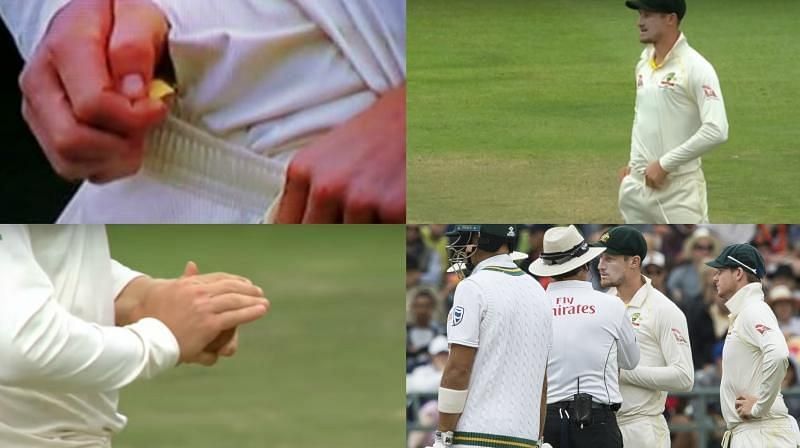
Sandpaper Gate Aftermath: An impulsive move, or an act to safeguard the honourable legacy of the gentleman's game?

A bitterly-fought series reached its saturation point on Day 3 of the third test in Cape Town when the youngest member of the Australian team was spotted rubbing a piece of sandpaper with the ball to alter its condition in his team’s favour. Later that day, his captain admitted that the act was premeditated and a brainchild of the ‘leadership group’ of the team. What followed was a week of shame, ridicule and embarrassment for Australian cricket.
Ball tampering in cricket is probably as old as the game itself. In the aftermath of the Cape Town incident, former England captain Mike Brearley asked if there is a cricketer who can put his hand on his heart and say he hasn’t done it. The ICC recognizes it as a Level 2 offence, which comprises a fine along with a one-test suspension.
It is far from the worst thing a player can do on a cricket field and nowhere close to the criminal act of match-fixing - as some headlines seemed to suggest. Tampering with the ball doesn’t guarantee success in the match; it only enhances the team’s chances by increasing the tendency of the ball to reverse-swing. In Australia’s case, it didn’t even work that way.
The respect for sportspeople in Australian society is above that for people from all other broad fields of endeavour. The position of captain of the cricket team is a privilege, not a right and holds a lot of importance.
Steve Smith earned it through years of hard work en-route to becoming the best test batsman in the world. During the same period of time, his deputy David Warner became the greatest all-format opener in modern international cricket. Two men determined to do all they could to win a match for their country. But when this passion turned into desperation, it all ended for them - just like that.
The Australian cricketers through their long-standing culture of sledging, hypocrisy and arrogance have too often pushed ‘the line’ conveniently created by them. So when Cameron Bancroft was caught red-handed, there was little sympathy on offer even from their own people. The Australian public was now losing its trust in the team.
What made matters worse was Smith’s shocking confession in the press conference of the act being pre-planned. This wasn’t just another case of on-field misbehaviour; it was premeditated cheating. The integrity of the team was questioned as every proud Australian cricket fan struggled to come to terms with the breach of their trust.
Few would have anticipated the magnitude of the public outrage that followed. One expected nationwide condemnation of cheating in a sport, but the widespread nature of the reactions and the lack of dissenting voices was a result of a combination of factors.
Firstly, the obviousness of Bancroft’s act left no doubt about his intentions - in the past, a number of ball-tampering incidents have been dubious enough for the accused players to claim innocence. Then came the revelation that it wasn’t a spontaneous mistake by a youngster in the team; it was the execution of a plan plotted by the leaders of the team. The build-up to this match had both Smith and Warner involved in sledges of varying degrees with South African players; this didn’t help their cases either.
Australia not only admitted to tampering with the ball, which in itself is a rare occurrence in cricket’s history, but also did the same at a time when the debate on their playing culture was gaining momentum; even the hardcore loyalists of the team who justified Warner’s innocence in his staircase fight with Quinton de Kock earlier in the series, were left with no reason to extend their support.
As for the outrage from the rest of the world, this incident served as the perfect opportunity to get back at the Aussies. Social media acted as an ideal platform for people to vent their anger and in no time, the national cricket team was showered with hatred.
The Prime Minister himself expressed disappointment and expected Cricket Australia to take decisive action. It was almost as if everyone demanded severe punishment for the trio, instead of asking for it. The pressure mounted on Cricket Australia to come up with a harsh reaction to the widespread outrage. A comprehensive investigation followed and resulted in year-long bans for Smith and Warner along with a nine-month ban for Bancroft, from all forms of top-level cricket.
While the move did raise a few eyebrows, it must be observed that the board had little choice. Under massive pressure from the fans and the media, Cricket Australia had a point to prove- that cheating is intolerable and will be appropriately punished even if the men in question include two of the country’s best cricketers.
The ICC’s sanctions were more in accordance with where ball-tampering stands as an offence in terms of the history of the game. Cricket Australia established a contemporary precedent by showing the world how those who bring disrepute to the gentleman’s game should be treated.
However, a mystery remains unresolved: did the leadership group only comprise of captain Smith and vice-captain Warner? They intended to help the bowlers by changing the condition of the ball and entrusted the team’s youngest player Bancroft with the job in the hope that he will escape the camera’s attention.
It definitely seems vague that such a decision was taken without consulting the bowling attack. Even if that is true, were Mitchell Starc, Josh Hazlewood, Pat Cummins and Nathan Lyon so naïve that they did not feel a difference on the surface of the ball when it was being worked upon by Bancroft?
The most feasible theory for this argument is that Cricket Australia adopted the damage control mode realizing the depletion of Australia’s batting lineup through the suspension of Smith, Warner and Bancroft; the least they could do was to retain their enviable bowling attack by denying its involvement in the incident. Remarkably, head coach Darren Lehmann too denied knowledge of the plan but in either case, his resignation was inevitable.

Another aspect worth noticing is the role of broadcasters in ball-tampering. In the last decade, all ball-tampering incidents have involved video evidence provided by the host broadcaster and in all cases, players from the away team have been caught tampering.
The concern for the game is the degree of control broadcasters have in such situations and the scope for manipulation of video footage to be aired and circulated. While provision of evidence for decision making and the DRS technology have completely been delegated to the broadcasters, the ICC should consider having a few cameras at every international match to at least monitor ball-tampering. This may not be cost-effective, but it will serve the greater purpose of preserving the image of the game.
So, what does the future hold for the suspended trio? Given the stature of Steve Smith and David Warner, they are expected to be back in the reckoning for Australia’s international teams across formats as soon as they become available. Even if Australia show reluctance to select them straightaway, they will get ample opportunities in leagues across the world to persuade the selectors to look at them.
Cameron Bancroft finds himself in a tricky situation with his career potentially jeopardized; he had barely cemented his place in the side and is unlikely to be considered by the selectors anytime soon after his return.
One can still argue that Cricket Australia would have been less stringent with the punishments had the public reaction to the incident not been as severe; having said that, this incident and its consequences will serve as a lesson to cricketers not only in Australia but across the world.